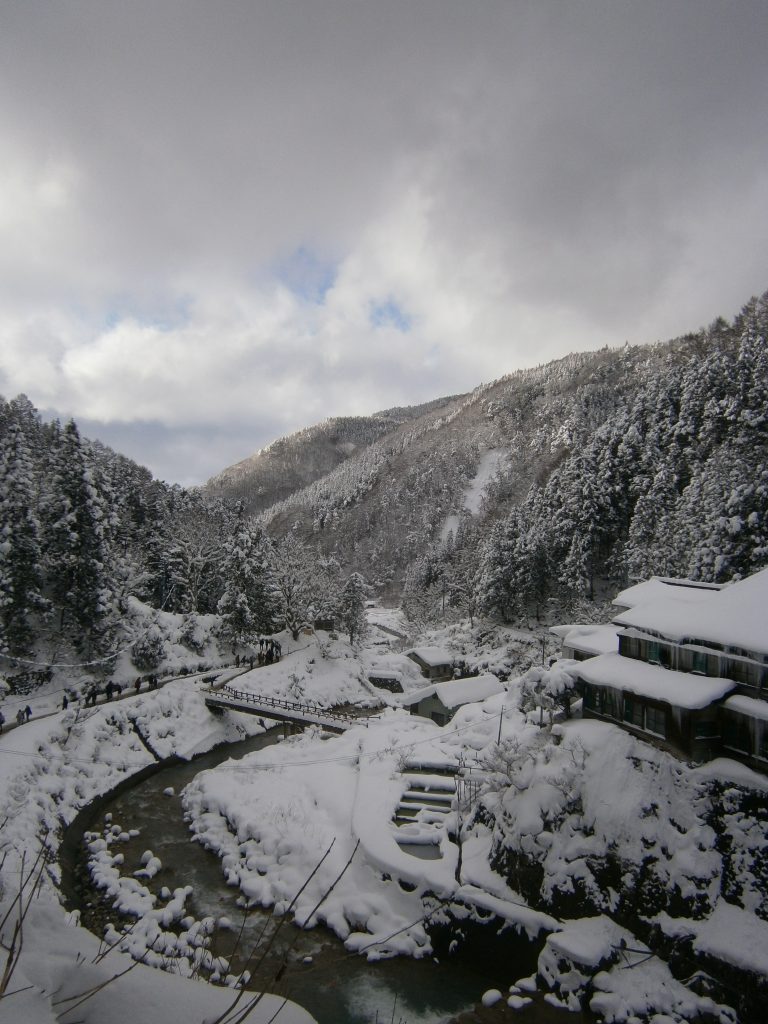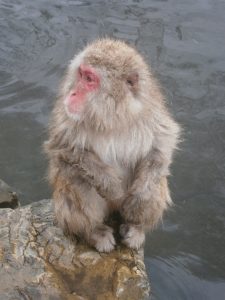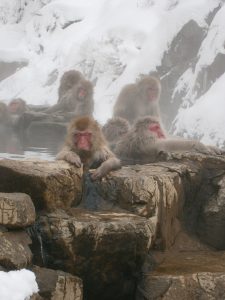It’s called Hell Valley for a reason. The vent up ahead cloys the air with its sulphurous belches. It spews mightily, staining the rocks yellow, but it still can’t melt the snow that lies, deadweight, on the mountainside. This side of the river is strewn with pipes and wires that burrow from the vent, through the snow and stretch across to the frozen hut opposite. It’s almost difficult to tell what is feeding what. Although it vomits and strains against its chains, most of the tourists have zero interest in the sulphur spring, or even the panorama created by the river curving through the valley. They are busy disturbing monkeys.
The macaques are huddled in the trenches that the warm pipes melt in the snow, trying to pick up some residue warmth for the long night ahead. They look on forlornly, apparently too cold to be bothered by the endless photoshoot. However, these aren’t the monkeys that the tourists came for. The really interesting monkeys are having a bath over the rise.
The macaques of Jigokudani Yaen-Koen get a fair amount of attention for this unique behaviour in response to the harshness of their environment. They live in a national park in the far north of Nagano Prefecture, deep within the Japanese Alps. Winters here are bitter, with heavy snowfall that lasts for days at a time. Since frozen fingers and toes aren’t great for a tree dwelling species, the monkeys here have taken over a remote hot spring, or onsen, to help them warm up during the day. This initially appears a little short-sighted. Being covered in wet fur and knee deep in snow seems like a swift end to life in the mountain wilderness. However, as the park signs explain, monkeys don’t sweat in the same way as humans. Their relative lack of pores means that water can keep them warm for far longer. The hot springs in the Snow Monkey Park provide them with natural heating and boost their chances of surviving the long nights in the trees.
Apparently, the monkeys have been visiting the area for at least 60 years, since they discovered that a local inn was also an occasional source of food that wasn’t buried in snow. [1] The creation of the park was of benefit to everyone: the monkeys received a protected habitat and their own private bath, while the humans weren’t constantly pestered by hungry macaques. It also helps to keep the other onsen free of monkey poo. In the winter, the food and the onsen make the monkeys an almost guaranteed sight, so for photographers it’s definitely worth making the journey to see them.
But how easy is it to get to the park? Nagano may be deep into snow country, but the ski resorts in the area mean that the roads aren’t impassable. With snow tyres or chains, it’s possible to drive right up to the entrance of the park. Failing that, there’s a train line into Yudanaka Station, where it’s possible to take a bus to the park. [2] There are plenty of road signs to the monkey park from the town of Yamanouchi, although when driving it’s quite easy to miss the turning to the park itself. If the turning heads straight up the mountain to nothing, then it’s probably the right direction.
What’s more difficult is leaving civilisation behind and trudging for about 30 minutes through the snow of Jigokudani. While it’s not an experience reserved for the hardiest of souls, it’s a fair trek from the trailhead to the gate of the monkey onsen. In January, the path is ice for most of the way, with a steep drop through the pines on one side and a stream on the other that appears and disappears as the snow wills. It’s best to wrap up warm and bring hiking or snow boots to avoid an unscheduled skiing experience. These can be rented at the trailhead for a fairly extortionate price. In general, winter in Nagano isn’t kind to feet, so leave the sandals at home.
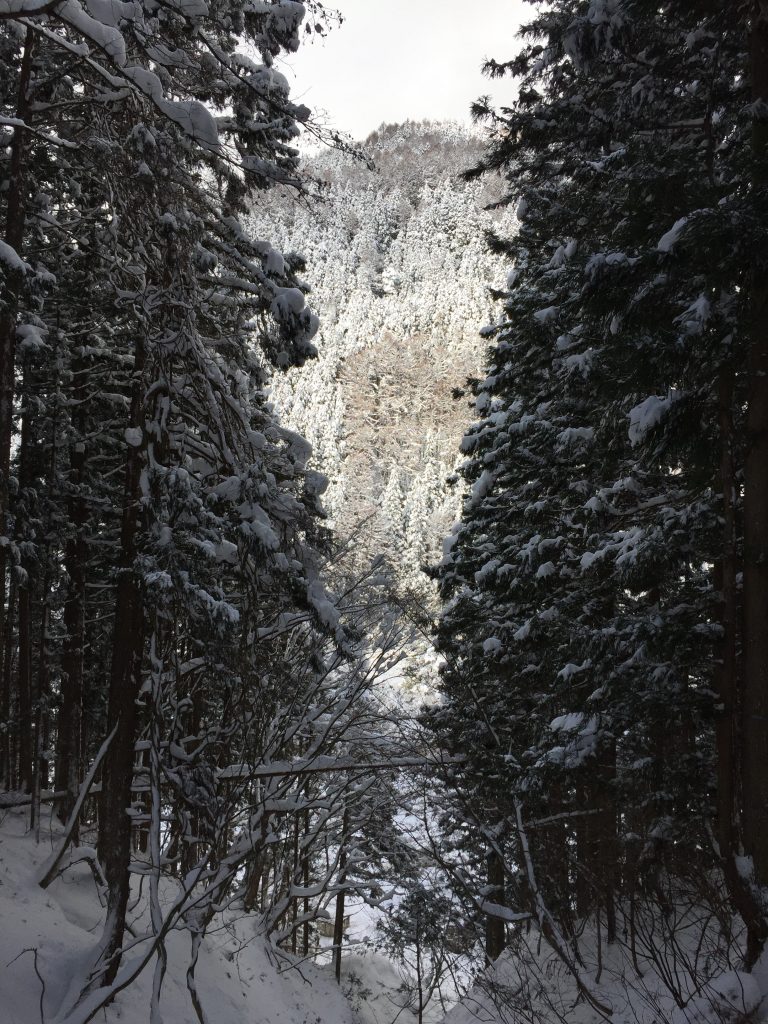
Eventually, the onsen buildings come into view around the crest and signs of primate life start to dot the mountainside. A couple of monkeys wander brazenly along the paths, looking unfriendly. However, unless they feel threatened, they are largely indifferent to people. It’s probably too cold for any monkey business. Don’t fill up the camera just yet, though. Head up the slope and through the ticket gate, where the real prize is to be found.
The majority of the troupe is submerged to the neck in the waters of a private pool, perched on a ledge above a river. Some of the larger monkeys stand guard on the edge of the onsen, eyes fixed on the forest above and the iron grey of the river below. The infants are the most active, dipping in and out of the pool and fighting on ledges out of the reach of tourists. Most of the adults are content to sit, grip the sides and perhaps be checked for ticks. Many have their eyes closed. It’s probably the only way to truly relax with a gaggle of tourists on two sides of the bath. Several of the sentries are perpetually ready for a close up, safe in the knowledge that this is their kingdom. Just don’t expect them to move too much.
It’s possible to go right up to the edge of the pool on one side, but generally the monkeys seem to prefer facing away in the direction of the river. There is also a lowered area on that side for people to take photos. This is probably where the best Instagram shots are taken, but be prepared to wait for an opening, as it’s usually crowded with ridiculously oversized lenses and selfie sticks. It’s worth braving the ice and jostling for an opening:
One of the most torturous things about the Snow Monkey Park is that the monkeys are enshrined in the steam, loving every minute, while the frozen tourists can only look on enviously. After stumbling through the cold, slipping on the ice and numbing fingers to take photos of monkeys languishing in the heat, the feeling of being pressed up against the glass can be difficult to take. The actual monkey onsen would probably be a horrible experience, since it’s filled with monkey litter. However, after a couple of hours out in the snow, it’s nice to round off the day with a hot bath of one’s own. Luckily, Yamanouchi and the surrounding area have a range of onsen experiences for humans to choose from. There are several bath houses within easy driving distance and even a couple of onsen towns, Yudanaka and Shibu, close by. [3] These provide a range of experiences. The best however, are the outdoor pools, where the worry is less about the cold air and more about sitting incredibly still. Some onsen are so hot that waves lapping against the skin make the waterline feel like the inside of a kettle. A little further out, Maguse Onsen in Iiyama has an outside pool with a stunning view. It comes highly recommended as a way to finish the day.
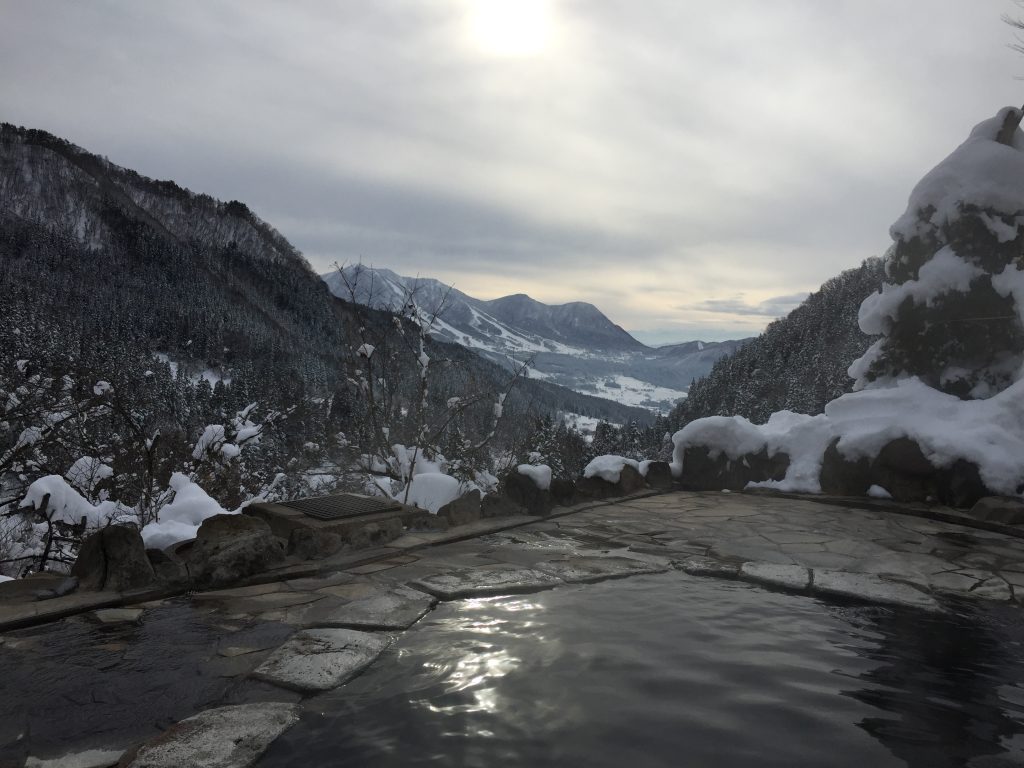
Soon winter will end, the snow will melt and the monkeys will return to the forest. This is an event that happens in a remote valley, for a couple of months a year, with no guarantee that the monkeys will be here beyond a certain date. But that is no reason not to go. It’s never been easier to get out into the Japanese wilderness. The shinkansen is still famously punctual, and with the Tokyo Olympics coming up, the whole of Japan is working on improving its tourism services and particularly its level of English. This means that the next few years are a golden opportunity to see the more remote parts of Japan. Tokyo and Osaka will be there forever. But what about the chance to travel deep into the Japanese wilderness, look nature in the face and feel the connection all living beings share in the struggle to survive? It’s better to come now. Who knows when winter will end and the chance will disappear over the horizon.
The following websites were helpful in the creation of this article. They may also be great inspiration for a trip to Nagano.
Go Nagano – the official tourism guide to Nagano Prefecture – http://www.go-nagano.net/shisetsu-detail?shisetsuid=107001001
Japan Guide – a one stop shop for practical information about the Snow Monkey Park, and Japan in general – https://www.japan-guide.com/e/e6028.html
Snow Monkey Resorts – contains further information on the monkeys – http://www.snowmonkeyresorts.com/smr/snowmonkeypark/
References:
[1] http://www.snowmonkeyresorts.com/smr/snowmonkeypark/history-of-the-jigokudani-monkey-park/
[2] http://www.snowmonkeyresorts.com/2016/12/bus-or-train/
[3] https://www.japan-guide.com/e/e6028.html

